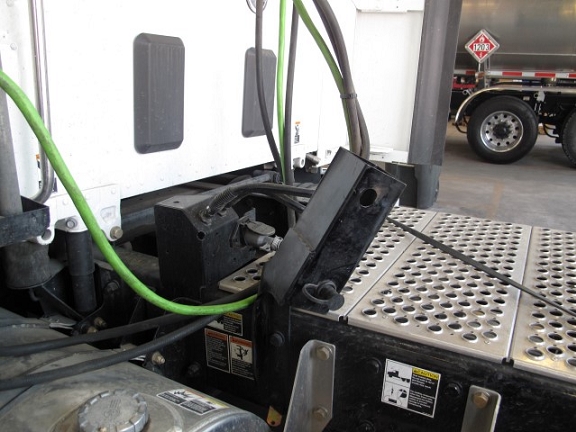A fire, apparently electrical in origin, damaged a 2015 Kenworth T680 truck. GEI was assigned to determine the fire’s point of origin and its ignition cause. We were also assigned to research the National Highway Traffic Safety Association website database for recall issues that may have caused or contributed to the fire.

First, the available recall information provided by the NHTSA website showed no recalls for issues that would have caused or contributed to the date-of-loss fire.
Next, the vehicle was examined and documented photographically. The exterior of the vehicle was examined. The fire had not damaged the exterior of the truck. The wheels were found properly secured to their respective hubs. The Goodyear brand tires were found inflated and properly mounted to their wheels.
The interior of the cab was examined. No pre-fire electrical problems were found in the cab’s interior. The stock wiring routed to the ignition switch, heater ventilation and air conditioning controls, stereo/radio unit, or the auxiliary power sources showed no indications of pre-fire short-circuits or other electrical issues. The fire did not start in the sleeper cab.
The engine compartment was examined, starting at the fuel injection system. No indications of fuel wash or fuel spray patterns were found at or near the fuel injectors. The fuel injection system lines, hoses, and supporting components were in place and intact prior to the fire. The fire pattern did not support a fuel injection system fire point of origin.
The components, lines, hoses and other supporting components of the power steering and air conditioning systems were examined. No fire activity was found in the areas of these components; no fire points of origin or fire causes were found in these systems.
The radiator, mounted at the front of the engine compartment, was found in good condition. No damage was found to the batteries located on the left side of the cab under the driver’s door.
No damage was found to the fuse boxes located at the left rear of the engine compartment, which was mounted on the left front cab wall. This area of the wiring harness was only lightly heat damaged.
The inspection continued from the rear of the truck forward. The bracket for the auxiliary external power supply was hit or bent, apparently as the truck “jack-knifed” or completed a very sharp turn that allowed the attached trailer to contact and bend the auxiliary external power supply bracket.
This damage partially crushed the green trailer power supply cable causing a short circuit.
The short-circuit then proceeded to damage the wiring harness, starter, and engine control computer.
The heat from the short-circuited trailer power supply cable also partially melted the red cable terminal insulator. The battery cable connections to the starter were damaged by the fire, as were the other surrounding electric control unit connectors. The short-circuit in the power cable at the rear of the truck overheated the power cable traveling forward to the starter area. As this cable runs under the truck the ambient air kept this heavy-duty cable insulation below its fire ignition temperature. However, as this cable turned inward at the starter it ran adjacent to many smaller and lighter gauge wires. The power cable generated sufficient heat to melt though the tangled, light plastic tubing wiring harness jacket. These lighter wires’ insulation reached their fire ignition point and ignited the surrounding plastic insulation of the wiring harness near the starter.
In conclusion, there were two problems with this almost-new truck. First, a sharp turn could damage a bracket and pinch a large gauge cable. Secondly, a shorted cable was not sufficiently protected by a fuse or circuit breaker to prevent overheating by a short circuit and a resulting electrical fire.


